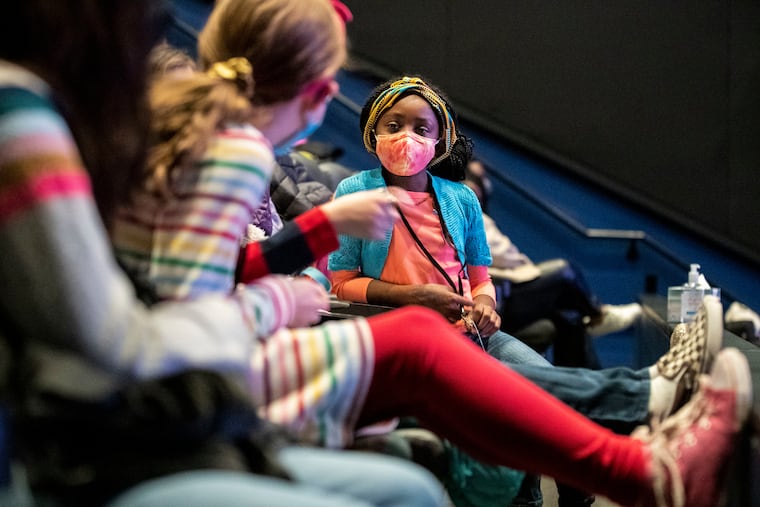A little girl didn’t see herself in fairy tales. So her family made a movie.
The Rainbow Prince, made by a Bucks County family to be shown in schools, inverts gender roles, with the princess saving the prince. And both characters are royalty of color.

Marea Claybourne-Napier was 5 years old and considering the world of fairy tales when she asked her mother a question: Where were the princesses who looked like her?
On Sunday, Marea, now 10, watched along with families and children at the County Theater in Doylestown as the idea she inspired and helped turn into a story was brought to life on the big screen.
“It was nice to see it in the real theater,” Marea said after the screening of The Rainbow Prince.
Based on a story written by Marea and her mother, writer-director Laura Napier, and made into a movie by Napier and Marea’s father, film producer Doug Claybourne, The Rainbow Prince is a twist on traditional narratives. Its hero is a princess who rides in on horseback to save a prince who has been placed under a spell. Beyond the inversion of gender roles, both characters are royalty of color. (The prince, Rainbow, changes colors depending on his mood, but brown is his “happy color.”)
Children’s programming as a whole has grown more diverse in recent years, Napier said. Still, when Marea —who is Black — asked about brown princesses, she saw a dearth of representation in a powerful mode of children’s storytelling.
“Fairy tales stay with kids,” said Napier, whose family lives in Buckingham Township. “They’re really important as part of their consciousness.”
And so a five-year project was born. Napier and Marea began brainstorming the story aloud — with Marea deciding such details as what color skin the story’s queen should have. Then Napier began putting it into writing, creating a children’s book with illustrations by Marea.
“We thought, ‘This has to be a film,’” Napier said. Having to raise the money for production themselves, and wanting the movie to be shown in schools, they decided to keep the film to 30 minutes — short enough to be played in a single class period, with time for discussion afterward. “We wanted to give schools every reason to say yes,” Napier said.
They recruited actors, actresses and crew who agreed to work under the Screen Actors Guild’s “ultra low budget” project rates — with much of the filming taking place last summer, while the cast spent two weeks in the dorms at Arcadia University.
Napier and Claybourne, who are both white, said they worked hard to hire people of color and sought input on the script — sensitive to the fact that “here we are, a white couple trying to do this movie about a brown princess saving a prince,” Napier said. But “this is Marea’s story. And, hopefully, Marea will grow up and tell more of her stories.”
Marea — who appears in the film, wearing a pink princess dress and running with her arms open toward Doylestown’s Fonthill Castle — chose the actress who plays the older version of herself, Clare-Hope Ashitey.
Hope-Ashitey, who lives in England, said in a video accompanying the project that “if the cultural output of society doesn’t reflect you, you can never feel truly a part of it.”
Other cast members were on hand for Sunday’s screening, including actor Dwayne Moore, a Queens native who plays Prince Rainbow — the character targeted by the spell of the “White Wizard” and a sidekick who proclaims that when they take over Rainbow’s kingdom, “we’ll make colors against the law.” (Before they’re foiled by Princess Marea, the two characters fly on a broom, a moment that the real-life Marea and other children said was their favorite part of the film.)
Moore, who also works in college counseling for a charter school network in New Jersey, said in an interview that the film’s visuals are powerful.
Kids may not remember a story line for line, “but they will remember how they feel,” he said.
As the credits rolled, accompanied by Marea’s drawings, the several dozen adults and children in the theater applauded — the latter group particularly as some of their own names popped up among the extras.
Addressing the cast after the screening, one woman thanked them, saying that as a Black Latina woman who came to the U.S. 20 years ago, “looking for literature where my kids could feel reflected ... was really challenging.”
Rochelle Burton, who is African American and lives in Philadelphia, and whose 8-year-old son was an extra, said it was “so nice to see children of all different races playing together” in scenes, and that the film’s depictions allowed children of color “to be able to see yourself in the future.”
Marea’s school, Buckingham Elementary, has already shown the film to several fourth-grade classes, Napier said, and the aim is to next screen it in more Bucks County schools, as well as Philadelphia and New York. (Under an arrangement with the Screen Actors Guild, it can be distributed to schools for free and shown for 13 weeks per educational market, the couple said.)
“We’re looking at the longer game here,” Napier said, “and how many kids are changed just by having a different perspective of each other.”